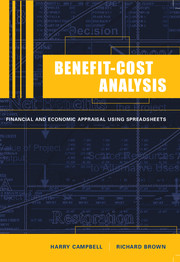Book contents
- Frontmatter
- Contents
- List of figures
- List of tables
- Preface
- Acknowledgements
- 1 Benefit-Cost Analysis: Introduction and Overview
- 2 Investment Appraisal: Principles
- 3 Investment Appraisal: Decision-Rules
- 4 Private Benefit-Cost Analysis: Financial Analysis
- 5 Efficiency Benefit-Cost Analysis
- 6 Calculating the Net Benefits to the Referent Group
- 7 Consumer and Producer Surplus in Benefit-Cost Analysis
- 8 Valuing Traded and Non-traded Commodities in Benefit-Cost Analysis
- 9 Incorporating Risk in Benefit-Cost Analysis
- 10 The Social Discount Rate, Cost of Public Funds, and the Value of Information
- 11 Weighting Net Benefits to Account for Income Distribution
- 12 Valuation of Non-marketed Goods
- 13 Economic Impact Analysis
- 14 Writing the Benefit-Cost Analysis Report
- Appendix 1 Case Study Assignment
- Appendix 2 Discount and Annuity Tables
- Index
14 - Writing the Benefit-Cost Analysis Report
Published online by Cambridge University Press: 05 September 2012
- Frontmatter
- Contents
- List of figures
- List of tables
- Preface
- Acknowledgements
- 1 Benefit-Cost Analysis: Introduction and Overview
- 2 Investment Appraisal: Principles
- 3 Investment Appraisal: Decision-Rules
- 4 Private Benefit-Cost Analysis: Financial Analysis
- 5 Efficiency Benefit-Cost Analysis
- 6 Calculating the Net Benefits to the Referent Group
- 7 Consumer and Producer Surplus in Benefit-Cost Analysis
- 8 Valuing Traded and Non-traded Commodities in Benefit-Cost Analysis
- 9 Incorporating Risk in Benefit-Cost Analysis
- 10 The Social Discount Rate, Cost of Public Funds, and the Value of Information
- 11 Weighting Net Benefits to Account for Income Distribution
- 12 Valuation of Non-marketed Goods
- 13 Economic Impact Analysis
- 14 Writing the Benefit-Cost Analysis Report
- Appendix 1 Case Study Assignment
- Appendix 2 Discount and Annuity Tables
- Index
Summary
Introduction
If benefit-cost analysis is to assist in the decision-making process the analyst must be able to convey and interpret the main findings of the benefit-cost analysis in a style that is user-friendly and meaningful to the decision-makers. The analyst should never lose sight of the fact that the findings of a BCA are intended to inform the decision-making process. BCA is a decision-support tool; not a decision-making tool. To this end it is imperative that the report provides the decision-maker with information about the project and the analysis which is directly relevant to the decision that has to be made, and to the context in which it is to be used.
There is no blue-print for report writing, as every project or policy decision will be different in various respects, as will the decision-making context and framework within which the analyst will be operating. Good report writing is essentially an art that can be developed and refined through practical experience. The purpose of this final Chapter is to identify what we consider to be some of the key principles the analyst should follow when preparing a report and to illustrate how these might be applied in the drafting of a report on the ICP Project we have used in previous chapters as a case study. As an illustration, we have selected the report prepared by one of our postgraduate students at the University of Queensland, Australia, who has kindly given us permission to use it in this way. In the sections below we explain why we consider this study an example of good BCA reporting.
- Type
- Chapter
- Information
- Benefit-Cost AnalysisFinancial and Economic Appraisal using Spreadsheets, pp. 304 - 331Publisher: Cambridge University PressPrint publication year: 2003



